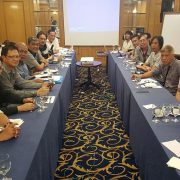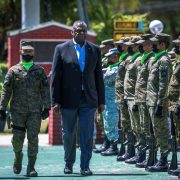A visit to Ka Oris’ guerilla camp
A former radio broadcaster recalls her visit to a New People’s Army camp and interview with Jorge Madlos who cultivated warm relations with many journalists for several decades.
By Katniss
It was in June 2004. I was invited to climb the mountains and trek the forests of Surigao to see Ka Oris. I was told farmers in Surigao communities as well as the “nice people” there are avid listeners of the radio program I anchored. The radio station on which my radio program aired, though based in Cebu City, could reach as far as Mindanao, particularly in the provinces of Surigao. Ka Oris wanted me to share ideas about how our radio programs were produced and he also wanted me to share my experiences and help them in setting up programs in certain regions in Mindanao.
From the highway, it was two to three hours ride on a habal-habal (a motorcycle kitted with wood planks that take in more passengers and cargo). Then it was more than an hour of walk into the forests and patches of farms before I finally reached a huge guerilla camp. There was a huge stage made of hard wood where cultural activities were being held; a kitchen area; and several makeshift huts and barracks where visitors like me are accommodated serving as our sleeping area. It was still daylight when I reached the place. Everyone was wearing boots because, even if it wasn’t raining, one cannot avoid walking on muddy grounds. I was also told that, since it’s a forest, there were also leeches. At that time and at that age I was not so worried about the leeches then but more so about the difficulty of walking and moving around in those heavy rubber boots. I saw several young guerrilla fighters and was told that they were on military training. There were two other foreign visitors in the camp. They told me they were from BBC, documenting the training and interviewing about the guerilla war in the Philippines.
After dinner, I overheard one Red Fighter who whispered to one woman in charge of the camp that there is a report of suspicious movements in the peripheries of the camp. The woman instructed the fighter to send a squad to check.
On my first night, I was not able to sleep while lying in a hammock in the barracks. I was so bothered with what I’ve heard. What if are attacked? What will I do? I could not run in those boots. What if I am hit or arrested? Sleep would not come despite the exhaustion. My mind was preoccupied with “what ifs” I felt paranoid. At 9 pm, I started having chills. It was either due to the coldness of the night inside the forest or because of the anxiety that I felt. I decided to rise and go to the hut of Ka Oris and his wife. I told him what I felt and how worried and scared I was. Calmly, he explained something which to this day I can still vividly recall.
He told me: “In this camp, which is in a deep forest, there are more than 100 red fighters. In our surrounding peripheries there are squads on guard while doing their mass work. Beyond the peripheries are mass bases. All this means that those supposedly unknown movements detected may just be some farmers who are on their way to their farms. If they are really soldiers or enemies, they must be a handful who may have just wandered around. The squads can take care of them. Otherwise, if the enemy has targeted our camp, they could not just send a few troops, knowing our strength. Usually, feeling insecure in battles, their ratio is one NPA red fighter to 10 of their soldiers. With the number of troops that we have here in this camp, they need to send a battalion of soldiers. If they do so, such huge troop movement can already be detected several tens of kilometers away from us.”
So I asked him, “What if they send troops by helicopter?”
He answered, “Well, in one helicopter there are only less than 10 who can be carried. They could also not land in this forest itself but perhaps in the peripheries where there are patches of farmlands. And we have the capacity to shoot at helicopters.” Ka Oris went on to tell me about an incident in the 80’s incident when the very camp we were at suffered aerial bombing by government forces. He said they were able to fight back then and the enemy failed to penetrate the forest.
Oris calm explanations relaxed me and I was able to finally sleep in my hammock.
I again visited him in his hut the following morning. I started my interview with him regarding the series of press conferences he conducted with journalists from all over, as well as politicians in the guerilla areas. I had long been curious about how were they able to do that despite the risks of being attacked. He again explained their application of strategies and tactics taught by Sun Tzu’s ‘Art of War.’ That interview made up for an entire episode of my radio show.
I was star-struck by him, I admit. He was gentle, calm and witty. He also looked like Ho Chi Min. Ka Oris invited me to quiz me on radio production, but it was I who learned so much from them. Their life was difficult, something I could not imagine myself doing nor enduring. City slickers like me who are easily afflicted with fear may find living their life impossible. But Oris and his guerilla army looked like it was a life worth living. How profound, noble, and self-fulfilling it seemed.
I wanted another visit and another opportunity to interview Ka Oris. But I got pregnant in the last quarter of 2005 and got married soon after.
As a radio personality, I have had my share of death threats in 2005. I was accused as “a communist masquerading as a journalist.” I was advised to stop being a radio anchor for my safety.
I still keep on monitoring media interviews of Ka Oris by local, national and even international media. I am still be amazed by his brilliance and commitment to their revolution as well as his persistence in pursuing the humaneness of his communist ideals. But there remains in me a tinge of guilt for failing in a simple request he asked of me. When I was leaving their camp in 2004, he gave me a specialty notebook and a nice pen to hand over to his daughter. I tried but I never get the chance of meeting his daughter.
I left Cebu in 2015 and I remember that I brought that notebook and pen with me to where I relocated. After hearing of Ka Oris’ death at the hands of his enemies, I must commit to finding where I placed the notebook and pen. Who knows, one day, I will be able to meet his daughter in the future.
To Ka Oris, my highest salute. To his daughter, I still owe you the notebook and pen from your father. Like the many journalists who admire him, he will always be to me the kind, gentle, heroic icon of the Filipino people’s struggle for social justice and liberation. #
(“Katniss” is a pseudonym.)







